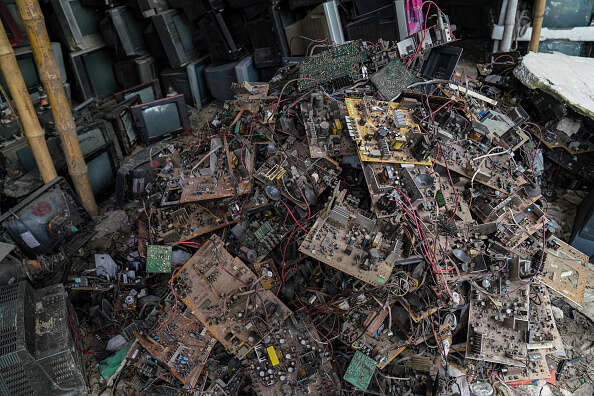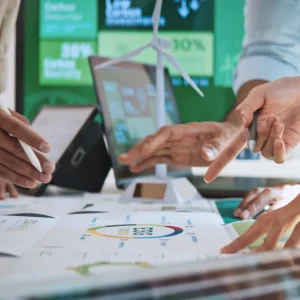
Eventually, the device you are using to read this article will break. Whether this will come as the result of an accident or through the slow accumulation of minor faults, the choice you will face will be the same: either to throw the device away, or go the extra mile and hand it over to your nearest e-waste specialist for recycling.

Most people and companies tend to choose the former. By 2030 the amount of global e-waste is projected to hit 74.7 million tonnes, roughly equivalent to eight times the weight of China’s Three Gorges Dam. Most of it ends up buried in landfill, or burned. Either fate contributes toward the slow degradation of the surrounding environment, filling the air with carbon emissions and other harmful gasses, or else seeing rare metal particulates leak into the soil and water supplies, poisoning local ecosystems and communities.
The environmental benefits of keeping these materials flowing inside the economy instead of landfills are therefore clear. A study conducted by Shield’s, a telco solutions provider, found that there is a lower carbon impact of up to 89% for reused equipment compared to purchasing new hardware. Additionally, there is a strong business case for telcos adopting circularity strategies within their daily operations, with a recent report by Accenture finding that the value of recycled hardware to the telco industry will lie between $45-$80bn annually by 2030.
The consulting giant also claims that $20-$30bn can be generated through the resale of infrastructure and waste mitigation in infrastructure installation, while $15 to $20bn is up for grabs through selling devices as a service and refurbished devices.
Perhaps unsurprisingly, circular business models are beginning to gain traction among telcos. For some e-waste sustainability experts, however, the execution of these policies leaves something to be desired - leading to questions of whether certain approaches may actually be doing more harm than good.
How telcos are tackling e-waste
One telco embracing the circular economy is Vodafone. In 2020, the company launched an internal asset marketplace, a business-to-business solution which allows the company’s vast network of operators across different markets to repurpose excess stock like fixed-line equipment, or decommissioned hardware like masts and antennas. This initiative is part of the telecoms company’s goal to reuse, resell or recycle 100% of its network waste by 2025.
According to Vodafone’s latest annual report published last month, the company generated an estimated 8,800 tonnes of waste so far this year and managed to recover and recycle 95% of it. Vodafone claimed that, as a result of its internal asset marketplace, the company reduced its CO2 emissions by 2,500 tonnes and saved a total of €10.8m. Plans are currently underway to roll out similar solutions to partner markets and other operators, according to the company’s chief corporate affairs officer, Joakim Reiter.
“The next frontier of our planet strategy is now focused on building a more circular economy for consumers and industry, and through own actions and in collaboration with partners developing innovative programmes that can tackle the growing challenge around electronic waste,” says Reiter.
Other British telco giants like Virgin Media O2 also have ambitious plans to implement circular economy solutions. The company has set goals to help its consumers “carry out 10 million circular actions by the end of 2025,” which might include recycling devices and donating old kit and unwanted smartphones. Earlier this year, it launched the ‘Tech Lending Community Fund’, which provides grants of up to 120,000 to councils and community groups in the UK to purchase refurbished devices to loan to refugees, ex-convicts and domestic abuse survivors.
Meanwhile, the Swedish telco operator Telia Company has made significant strides in its circularity strategy, with the goal of “zero waste” in its operations by 2030. In 2021, more than 70% of network waste generated was either reused or recycled. Additionally, almost 20% of Telia’s routers and TV set-up boxes sent to its customers were reused, according to figures provided to Tech Monitor.
Sara Nordbrand, head of sustainability at Telia told Tech Monitor that the industry needs “more concrete national and regional plans” like Nationally Determined Contributions with a clear road map to tackle e-waste. “This would speed up work, incentivize further collaboration and clarify the division of work, to progress further within this area,” she says. “Shifting to green energy won’t be enough – the broader circular shift needs to happen.”
The ‘paradox of e-waste’
Even so, some sustainability experts have lingering doubts about the effectiveness of e-waste collection methods and distribution processes. For example, the bulk of how electronic waste is collected at the moment is through “low touch” processes where people take their products to their local rubbish tip, explains Richard Peagam, global digital director at the Anthesis Group, a sustainability consultancy. In contrast, there are “high touch” e-waste collection methods that involve a more formal process with professionals processing and cleaning out hardware.
But Peagam explains that even high-touch environments might sometimes be counterproductive. He cites past examples of working with technology companies to improve their take-back schemes and seeing how little consideration was often paid to whether repurposing donated hardware was worthwhile.
“Any money made on the purchase of refurbished laptops, for example, was offset by the costs involved in getting rid of excess material,” he says. “That’s the paradox of e-waste, and you have to always think of it from the perspective of reducing harm. How do we make sure that these materials don't end up on a beach in the developing world? Or, are we more concerned about making money or adding value in the circular economy?”
While Peagam considers these circular strategies part of the solution to tackle climate change, telcos also face inherent challenges in ensuring that the nuts and bolts of the hardware they sell remain valuable long after consumers purchase them.
“The problem in the telco industry is that they’ve got cell phones that are potentially worth a lot of money from a circularity perspective with [their] high reuse potential,” says Peagam. “But, they’re also pushing out set-top boxes and routers that aren’t particularly useful at the end-of-life stage. If you take apart these items, there’s not a lot in there: it’s a big lump of plastic full of additives, flame retardants and plasticizers.”
“It’s very difficult to do anything useful with that because it’s so specialised,” he adds. “This is the problem we’re dealing with: companies ‘pushing tin’ when there might be a bit of value in the hardware. But, also, a lot of baggage comes with that value.”
“In reality, there’s only a handful of factories out there making routers and they’re all based in China and Taiwan, so you’re going to have to ship all this root material to the other side of the world to make that circularity happen,” says Peagam. In the end, “it’s far smarter to build robust equipment that just lasts longer”.






